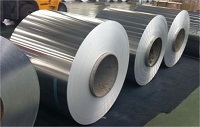The process of making एल्युमिनियम कॉयल typically involves several steps. Here is a general overview of the process:
ढलाई: The first step is to melt aluminum ingots or recycled aluminum to form a molten aluminum alloy. The molten aluminum is then cast into large rectangular-shaped molds called ingots.
Hot Rolling: The aluminum ingots are heated and passed through a series of rolling mills. The ingots are gradually reduced in thickness and lengthened in the process. This hot rolling process involves repeatedly passing the aluminum through sets of rollers to achieve the desired thickness.
Cold Rolling: After hot rolling, the aluminum strip is further processed through a cold rolling mill. Cold rolling involves passing the aluminum strip through a series of rollers at room temperature. This process refines the material, improves its surface finish, and reduces its thickness to the desired gauge.
एनीलिंग: The cold-rolled aluminum strip may undergo annealing, which involves heating it to a specific temperature and then cooling it slowly. Annealing helps relieve internal stresses in the material and improves its formability.
Slitting: The cold-rolled and annealed aluminum strip is typically slit into narrower coils of the desired width. Slitting machines cut the wide strip into narrower strips, which will become individual coils.
Coil Coating (Optional): If the aluminum coils are intended for specific applications, they may undergo a coil coating process. Coil coating involves applying a protective or decorative coating to the surface of the aluminum coils. This coating can provide corrosion resistance, improve aesthetics, or enhance specific properties.
Packaging: The final step involves packaging the aluminum coils for transportation and storage. The coils are typically wound tightly and secured with bands or straps to prevent unraveling or damage during handling and shipping.
